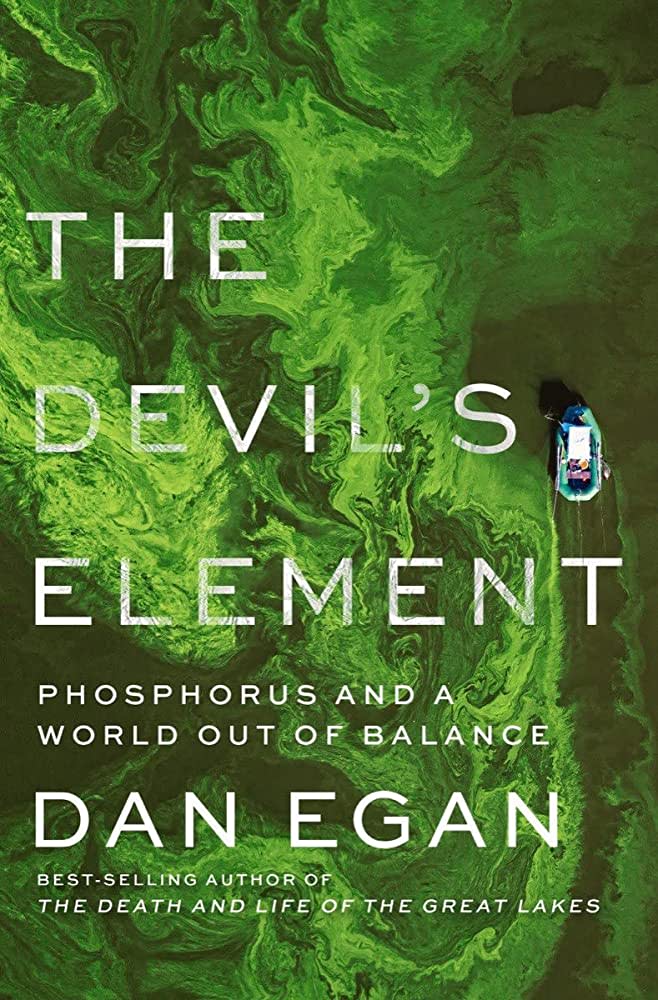'The Devil's Element' chronicles humanity's deadly dance with phosphorus
Phosphorus is essential; human beings can't live without it. Phosphorus is dangerous; it has been a key element in incendiary bombs.
Thanks to heavy use of phosphorus in fertilizers, many experts foresee it becoming a scarce resource. But too much phosphorus in the wrong places — in the runoff to lakes, ponds and rivers — leads to toxic algae blooms that ravage bodies of water, kill tourism and make people sick.
In his crisply written new book, "The Devil's Element: Phosphorus and a World out of Balance" (W.W. Norton), Dan Egan sounds alarms on both the scarcity and overabundance sides of the phosphorus-human equation.
Egan, a former Milwaukee Journal Sentinel reporter, previously wrote "The Death and Life of the Great Lakes" (W.W. Norton, 2017), which won the Los Angeles Times Book Prize and was a Go Big Read book at UW-Madison.

Egan has been on the trail of phosphorus as a catalyst for ecological calamity for some years, as evidenced by his 2014 series "A Watershed Moment," which included a deep exploration of the element's role in toxic algae blooms in Lake Erie.
Phosphorus, element No. 15 on the periodic table, was first isolated by Henning Brandt in Hamburg in 1669. An alchemist unsuccessfully groping his way toward creating gold, Brandt produced phosphorus as a byproduct of boiling vats of urine down to sludge. In a diligently nutty impulse, Egan wanted to replicate Brandt's experiment, until a chemistry professor talked some sense into him. Both Hamburg and the possible value inherent in urine return later in his book.
As humans grasped the power of phosphorus as a fertilizer, they raced to extract it from such sources as centuries of accumulated guano (bird poop) on oceanic islands and human bones left on battlefields. But the rate of usage has some experts warning that supplies will be depleted in decades.
There are geopolitical issues here, too, that have led Egan to compare phosphorus to oil. The largest known deposit of phosphorus rock is in the western Sahara, in territory controlled by Morocco, but where native Sahrawis continue to press for independence.
Now, onto problem No. 2, which hits Wisconsinites closer to home: "Fertilizer washing off agricultural lands is a primary driver of the algae blooms" that fill lakes and ponds with green goo. Green Bay is one body of water regularly affected by these blooms. While dubbed "algae blooms," these green horrors are actually made of photosynthesizing bacteria that produce powerful toxins, including one (anatoxin-a) scientists have dubbed "Very Fast Death Factor." The blooms kill fish — and Egan shares some horror stories of what their toxins have done to people.
Phosphorus in laundry detergents led to algae blooms in the 1960s and '70s. Under pressure from Rep. Henry Reuss of Wisconsin and others, the detergent industry gradually removed phosphorus from its products, and Lake Erie and other bodies of water returned to greater health — until the blooms came roaring back.
The Clean Water Act of 1972 set stringent requirements about what cities and industries could discharge into waters. But it largely exempted agriculture from those strictures, which Egan cites as a cause of the current crisis, given how industrial American farming has become. Animals produce large quantities of phosphorus-laden manure. Unlike human excreta, animal poop doesn't go through wastewater treatment. As manure spread on fields runs off into lakes, it stimulates growth of the algae blooms.
Egan states up front that his book isn't the last word on phosphorus issues, nor does he intend a survey of all possible solutions to this complex situation. But he checks in on some promising research, including projects reclaiming and repurposing human waste that would require one heck of a PR campaign to implement.
While it is easy to see phosphorus as the problem, Egan keeps reminding readers that balance is the issue. Serendipitously, one site in his book was home to the battle that later inspired a famous line in the comic strip Pogo: "We have met the enemy and he is us."
Our subscribers make this reporting possible. Please consider supporting local journalism by subscribing to the Journal Sentinel at jsonline.com/deal.
DOWNLOAD THE APP: Get the latest news, sports and more
This article originally appeared on Milwaukee Journal Sentinel: Dan Egan's 'The Devil's Element' details phosphorus crisis

